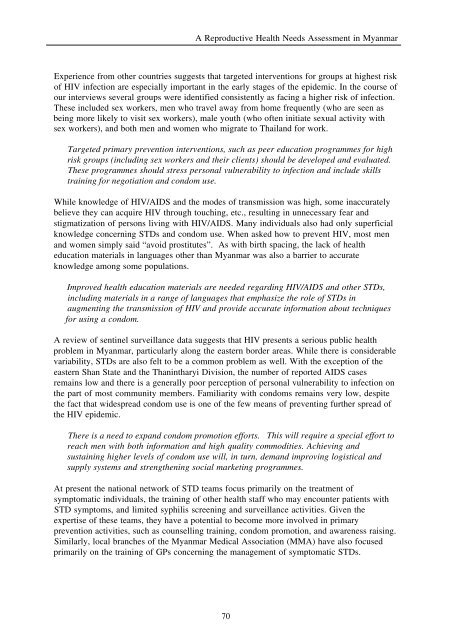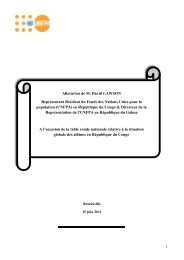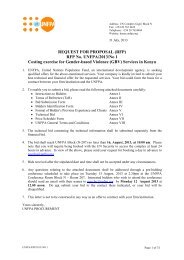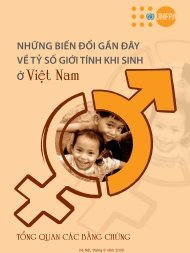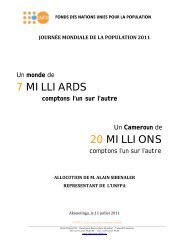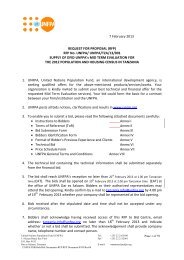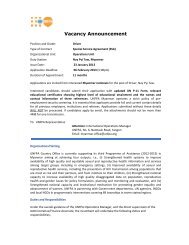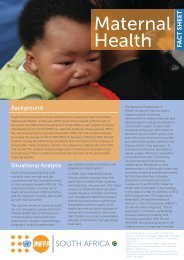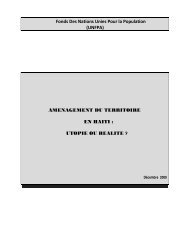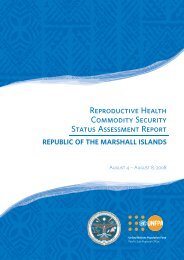A reproductive health needs assessment in Myanmar
A reproductive health needs assessment in Myanmar
A reproductive health needs assessment in Myanmar
You also want an ePaper? Increase the reach of your titles
YUMPU automatically turns print PDFs into web optimized ePapers that Google loves.
A Reproductive Health Needs Assessment <strong>in</strong> <strong>Myanmar</strong><br />
Experience from other countries suggests that targeted <strong>in</strong>terventions for groups at highest risk<br />
of HIV <strong>in</strong>fection are especially important <strong>in</strong> the early stages of the epidemic. In the course of<br />
our <strong>in</strong>terviews several groups were identified consistently as fac<strong>in</strong>g a higher risk of <strong>in</strong>fection.<br />
These <strong>in</strong>cluded sex workers, men who travel away from home frequently (who are seen as<br />
be<strong>in</strong>g more likely to visit sex workers), male youth (who often <strong>in</strong>itiate sexual activity with<br />
sex workers), and both men and women who migrate to Thailand for work.<br />
Targeted primary prevention <strong>in</strong>terventions, such as peer education programmes for high<br />
risk groups (<strong>in</strong>clud<strong>in</strong>g sex workers and their clients) should be developed and evaluated.<br />
These programmes should stress personal vulnerability to <strong>in</strong>fection and <strong>in</strong>clude skills<br />
tra<strong>in</strong><strong>in</strong>g for negotiation and condom use.<br />
While knowledge of HIV/AIDS and the modes of transmission was high, some <strong>in</strong>accurately<br />
believe they can acquire HIV through touch<strong>in</strong>g, etc., result<strong>in</strong>g <strong>in</strong> unnecessary fear and<br />
stigmatization of persons liv<strong>in</strong>g with HIV/AIDS. Many <strong>in</strong>dividuals also had only superficial<br />
knowledge concern<strong>in</strong>g STDs and condom use. When asked how to prevent HIV, most men<br />
and women simply said “avoid prostitutes”. As with birth spac<strong>in</strong>g, the lack of <strong>health</strong><br />
education materials <strong>in</strong> languages other than <strong>Myanmar</strong> was also a barrier to accurate<br />
knowledge among some populations.<br />
Improved <strong>health</strong> education materials are needed regard<strong>in</strong>g HIV/AIDS and other STDs,<br />
<strong>in</strong>clud<strong>in</strong>g materials <strong>in</strong> a range of languages that emphasize the role of STDs <strong>in</strong><br />
augment<strong>in</strong>g the transmission of HIV and provide accurate <strong>in</strong>formation about techniques<br />
for us<strong>in</strong>g a condom.<br />
A review of sent<strong>in</strong>el surveillance data suggests that HIV presents a serious public <strong>health</strong><br />
problem <strong>in</strong> <strong>Myanmar</strong>, particularly along the eastern border areas. While there is considerable<br />
variability, STDs are also felt to be a common problem as well. With the exception of the<br />
eastern Shan State and the Than<strong>in</strong>tharyi Division, the number of reported AIDS cases<br />
rema<strong>in</strong>s low and there is a generally poor perception of personal vulnerability to <strong>in</strong>fection on<br />
the part of most community members. Familiarity with condoms rema<strong>in</strong>s very low, despite<br />
the fact that widespread condom use is one of the few means of prevent<strong>in</strong>g further spread of<br />
the HIV epidemic.<br />
There is a need to expand condom promotion efforts. This will require a special effort to<br />
reach men with both <strong>in</strong>formation and high quality commodities. Achiev<strong>in</strong>g and<br />
susta<strong>in</strong><strong>in</strong>g higher levels of condom use will, <strong>in</strong> turn, demand improv<strong>in</strong>g logistical and<br />
supply systems and strengthen<strong>in</strong>g social market<strong>in</strong>g programmes.<br />
At present the national network of STD teams focus primarily on the treatment of<br />
symptomatic <strong>in</strong>dividuals, the tra<strong>in</strong><strong>in</strong>g of other <strong>health</strong> staff who may encounter patients with<br />
STD symptoms, and limited syphilis screen<strong>in</strong>g and surveillance activities. Given the<br />
expertise of these teams, they have a potential to become more <strong>in</strong>volved <strong>in</strong> primary<br />
prevention activities, such as counsell<strong>in</strong>g tra<strong>in</strong><strong>in</strong>g, condom promotion, and awareness rais<strong>in</strong>g.<br />
Similarly, local branches of the <strong>Myanmar</strong> Medical Association (MMA) have also focused<br />
primarily on the tra<strong>in</strong><strong>in</strong>g of GPs concern<strong>in</strong>g the management of symptomatic STDs.<br />
70


